Colosseum
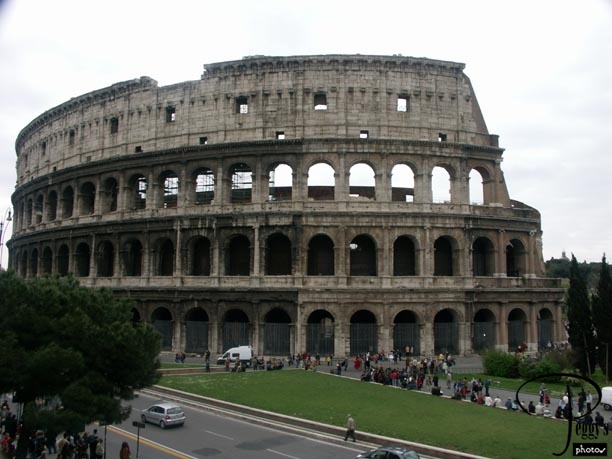
My day started off by receiving a phone call early in the morning from Rome Walks, the tour company from whom I had booked a walking tour of the Colosseum and the Forum for today. They needed two people to conduct the tour and the other people on the tour had canceled. They suggested that I pick up a guide at the Colosseum. So I went off to breakfast at the hotel––the Mercure Piazza Bologna. I decided on this hotel as it was where my Trafalgar escorted tour was to start from, so I wouldn’t have to change hotels when I started the tour, and also because it was close to a Metro stop. Breakfast items at the hotel: some odd ones of pasta and chicken (you could eat lunch or dinner for breakfast if you wanted), but also usually a hard boiled egg (brown), sausages, ham and cheese slices like we use for sandwiches, yogurt, all kinds of cereals, fruit, juice, coffee, and the most delicious breakfast pastries (the Italians certainly know how to make pastries). After eating breakfast (the pastries of course), I went back to my room and received another call from Rome Walks––the tour was on again (they found some new people who wanted to go on it), but it would be at 12 p.m. rather than at 10 a.m. I decided to go off to the Colosseum early and went off in search of the Metro stop after asking directions from the hotel desk. I made a wrong turn, which turned out to be a good goof as I located the neighborhood pasticcerie (pastry shop). I then found the Metro station and figured out how to buy a ticket (only 1 Euro). On a scale of 1 to 10, I would put the Paris Metro as an 8 (would be higher if it had escalators) and the Rome Metro as a 2 (a higher rating than it deserves but it did have escalators). The stations are dark and the trains are covered with graffiti (more about this graffiti later). The train was crowded but I only had three stops to go to get off at the Colosso (Colosseum) exit. The Colosseum was directly across from the Metro station.

Colosseum
Colosseum
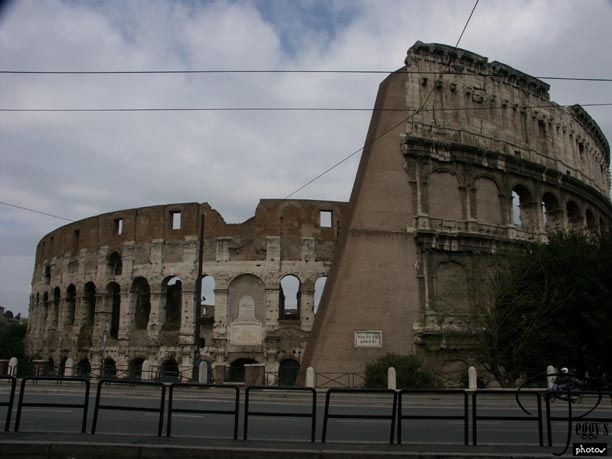
The Colosseum was commissioned by the Emperor Vespasian in A.D. 72 and was finished in A.D. 80. Its real name is the Flavian Amphitheater. It had 80 arched entrances and could hold 55,000 spectators. You have to picture the Colosseum as a structure covered with marble––white and colored––both inside and out. So what happened to all the marble: it was actually recycled in later years to be used elsewhere in Rome, such as for St. Peter’s Bacilica. Only part of the Colosseum’s outer ring remains. This photo shows where it now ends and how it has been shored up.

Colosseum
Colosseum
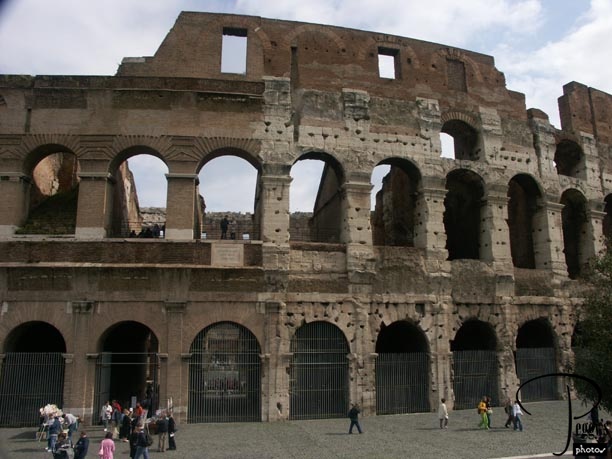
Another side of the Colosseum.

Colosseum
Colosseum
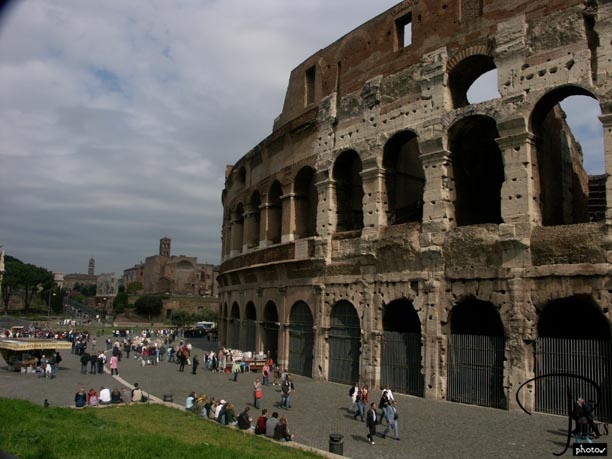
The side of the Colosseum looking to the Basilica of Constantine. A note: The Colosseum, the Forum, Palentine Hill, and the Trajan’s Markets, four major Roman sites, are all located very close to each other. You can explore this whole area in a day plus add on some more Roman sites here as well.

Colosseum
Time for Lunch
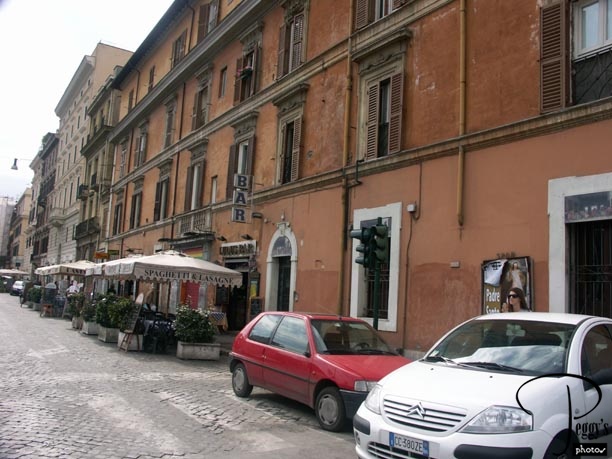
It was getting close to 11 a.m. and I thought that I had better eat something before the Rome Walks tour started. Right across from the Colosseum I saw a restaurant serving spaghetti and lasagna. Note the painting over the bottom of the walls on the buildings, probably over graffiti.

Time for Lunch
Time for Lunch
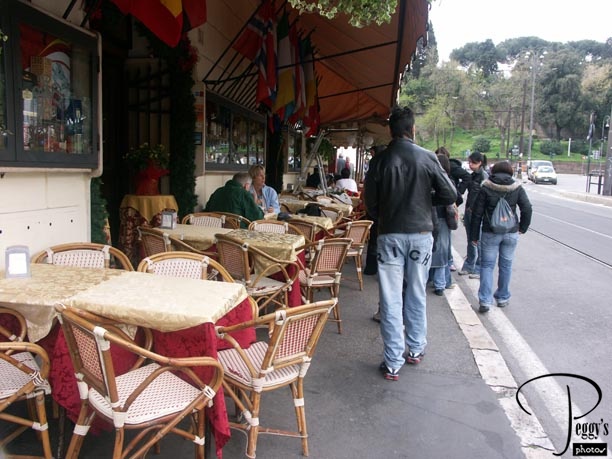
However, I decided to eat at this small cafe, picking an outside table to sit at which allowed me to look at the Colosseum while I ate. I had a margarita pizza and a light (diet) coke. About 11 Euros. The Italians make excellent pizza––very very thin crust––but you are not going to find pepperoni pizza or some other of the toppings that you are used to.

Time for Lunch
Metro Entrance
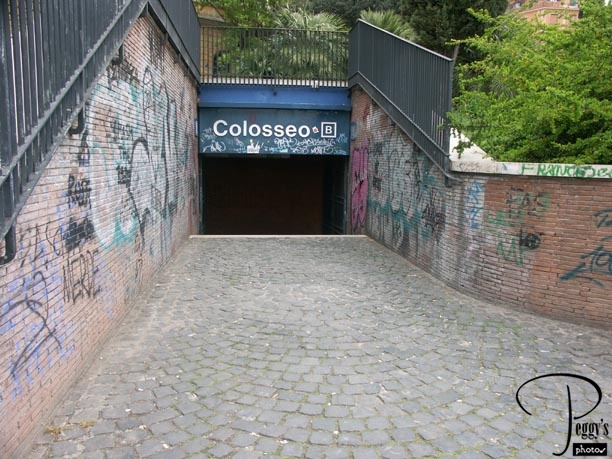
The instructions from Rome Walks was to meet at the terrace above the Colosseum Metro entrance. Take the elevator up to it through the Metro entrance. This photo shows the Metro entrance from the terrace. Not very inviting. So now a discussion about the graffiti that you see in Rome and elsewhere in Italy. You often see it on the bottom level of very nice buildings. The Rome Walks tour conductor and also my Trafalgar tour conductor told me that it is not gang graffiti––no Italian gangs have taken over Rome or Italy. Instead it is called “venting”––letting off some steam––and the graffiti is really of political comments, cheering for a soccer team, or just I love you to someone. It is allowed as people here remember that no political discourse was allowed during the fascist times in Italy.

Metro Entrance
Colosseum
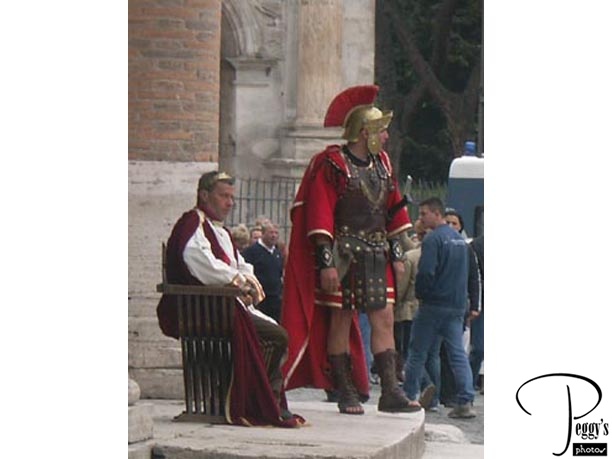
I met my fellow tour members at the terrace––a couple from San Jose, CA, and their son––and our tour guide––Greg, originally from New Hampshire (there went having a handsome, romantic Italian male taking us around, but Greg was handsome in his own non–Italian way). Greg’s major at Boston University was Roman History and he has been living in Rome for three years and I think it is likely that he will be living here for a very long time as he really likes living in Italy. Our whole tour lasted four hours––Greg gave us the complete history of the Colosseum and the Forum and I think of all of the Roman Empire. First, to the Colosseum. Outside the Colosseum, there are a number of people dressed up as gladiators and Roman citizens. They charge you for taking photos of them––I caught this photo on the sly.

Colosseum
Colosseum
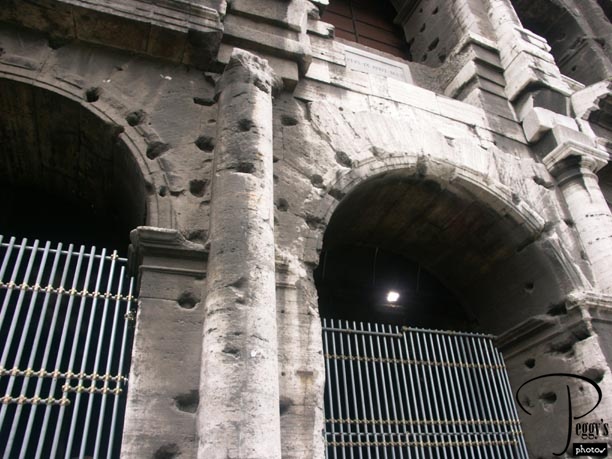
Photo of one of the arches of the Colosseum. When the Colosseum was built, they used iron pegs to align building parts. They were not structural posts. Good thing they weren’t, as during the Middle Ages, when people were very poor, they took out these iron pegs for their own use. Today, this makes it easy to distinguish a Roman ruin, as almost all the Roman ruins have this type of holes in them. In the Colosseum area, originally there was a huge bronze statue of Nero, but it was melted down for use in the Middle Ages.

Colosseum
Colosseum
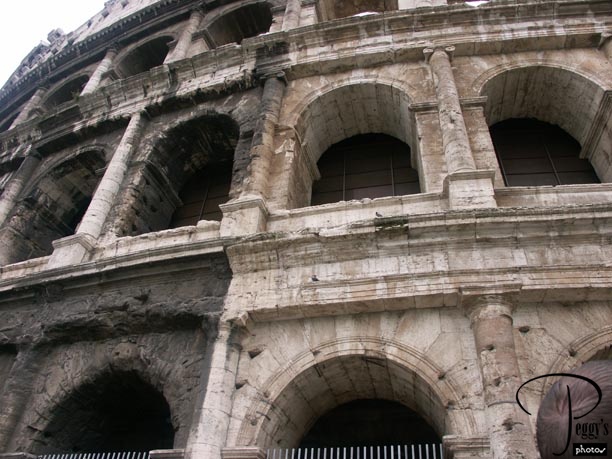
The Colosseum cleaned and not currently cleaned.

Colosseum
Old Roman Walkway
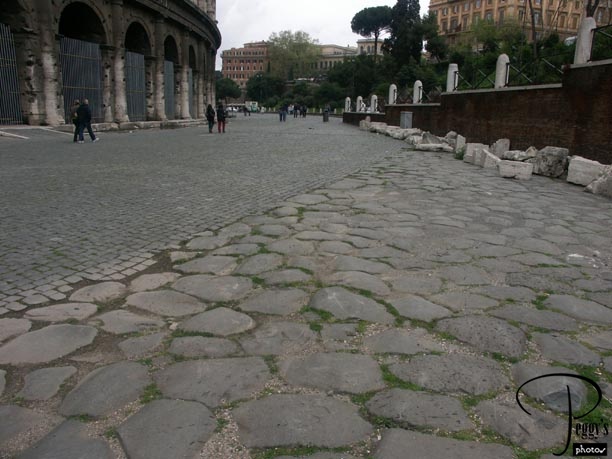
On the left of this photo, is the walkway built around the Colosseum in the Middle Ages; on the right, is the original Roman walkway. In Roman times, it was smooth and I think that it was covered also in marble.

Old Roman Walkway
Bollards
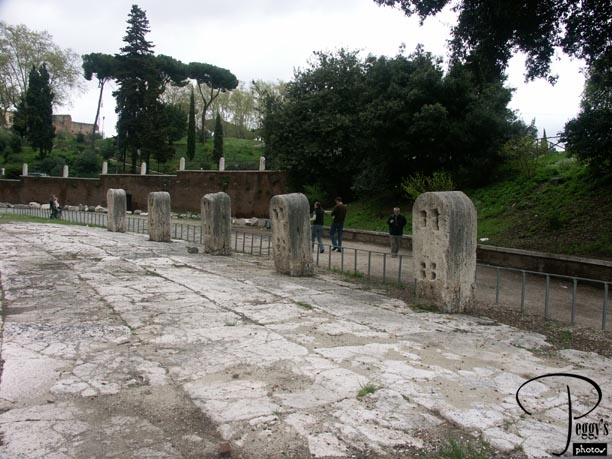
Quite surprisingly, I learned that the Colosseum was a covered stadium. There was what was called a velarium, which was a huge awning that provided shade. It was supported by poles attached to the upper story of the Colosseum and anchored with ropes attached to the bollards in this photo.

Bollards
Inside the Colosseum
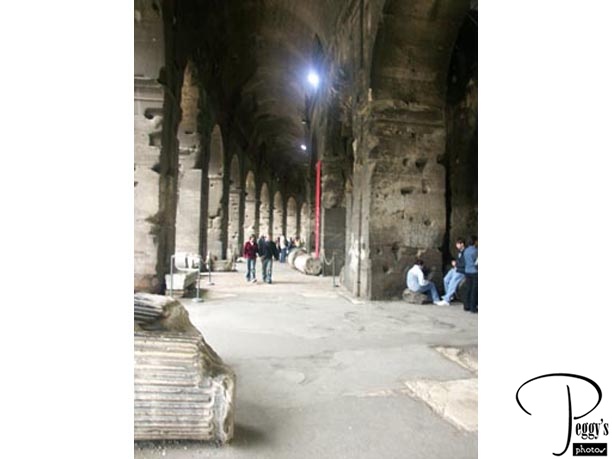
Inside between the outside rings of the Colosseum.

Inside the Colosseum
Inside the Colosseum

The bottom pits––this is where the gladiators and the animals waited. Greg and also my two books on Rome all said that it is doubtful, even though we have all seen Hollywood movies telling us otherwise, that Christians were fed to the lions here, though they possibly may have been in other arenas. The lower seats in the Colosseum were for the gladiators and people of higher social class. The nosebleed section was for the slaves. No admission was charged for the shows in the Colosseum.

Inside the Colosseum
Inside the Colosseum
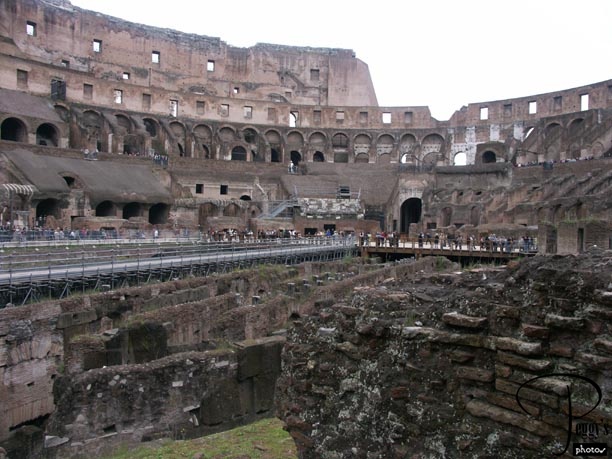
Another view of the interior.

Inside the Colosseum
Colosseum Wildflowers
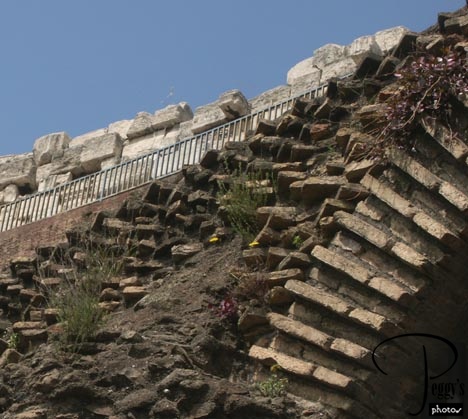
It was very odd seeing wildflowers growing on the Colosseum walls.

Colosseum Wildflowers
Colosseum Seating
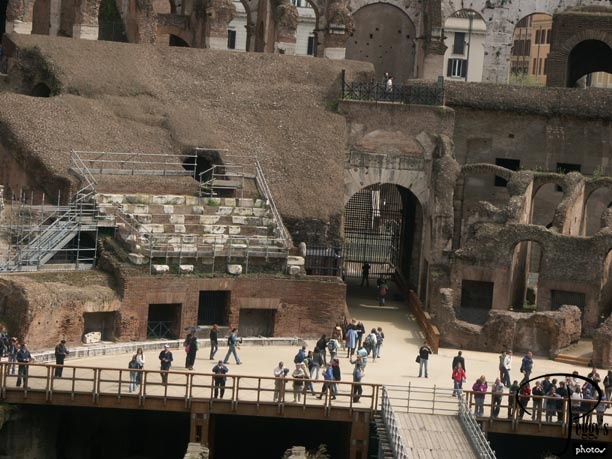
I think that the seats shown in this photo are the best preserved seats in the Colosseum.

Colosseum Seating
Inside the Colosseum
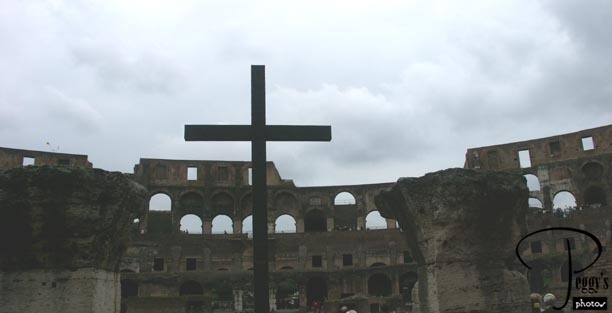
I don’t know when this cross was placed here, but it is an interesting addition.

Inside the Colosseum
Seat Marking
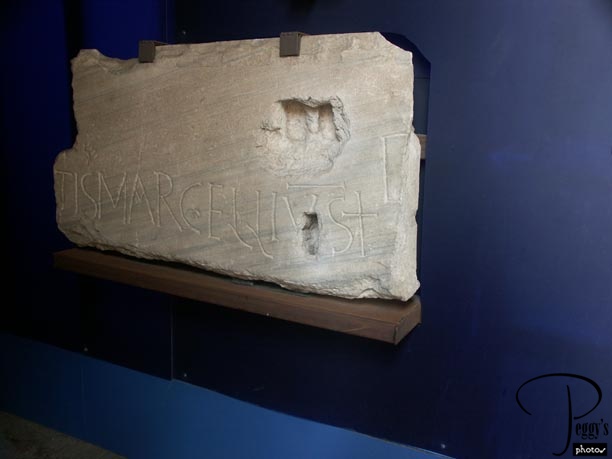
Some of the Romans marked their seats. Here is one inscription.

Seat Marking
Seat Marking
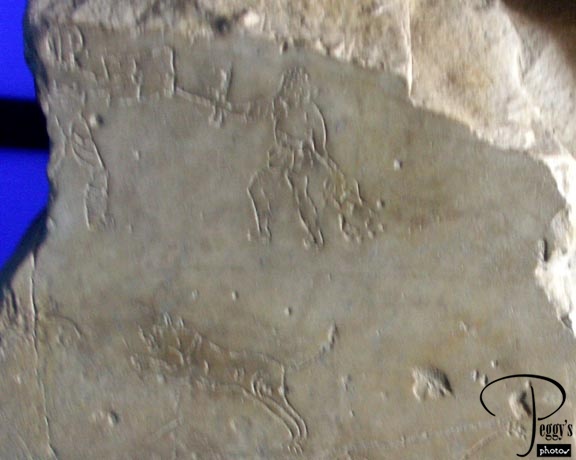
This is a fancier marking by a gladiator. You can see two gladiators fighting and what appears to be a lion or some kind of animal.

Seat Marking
Arch of Constantine
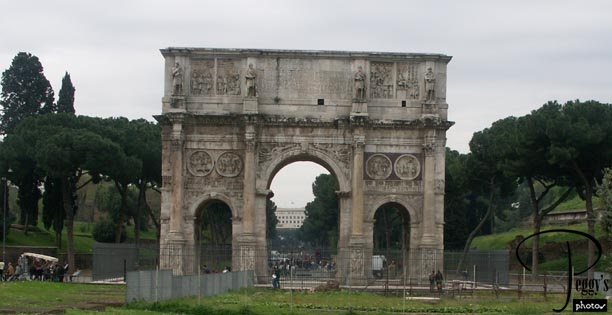
The arch was dedicated in A.D. 315 to mark Constantine’s victory over Maxentius, his co–Roman emperor. Constantine claimed that his victory was due to a vision he had of Christ. The arch marks one of the greatest turning points in history, as after his vision, Constantine became a Christian and he made Christianity the state religion of the entire Western world. However, there is nothing Christian about the arch and most of its decorative elements were taken from other monuments.

Arch of Constantine
Arch of Constantine
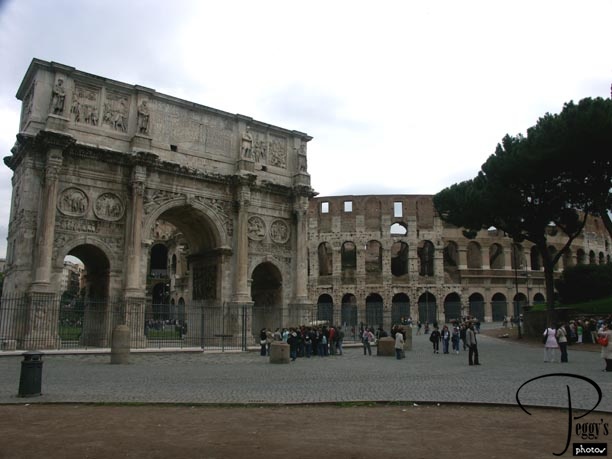
A view of the arch from the other side, showing also the Colosseum.

Arch of Constantine
Arch of Constantine
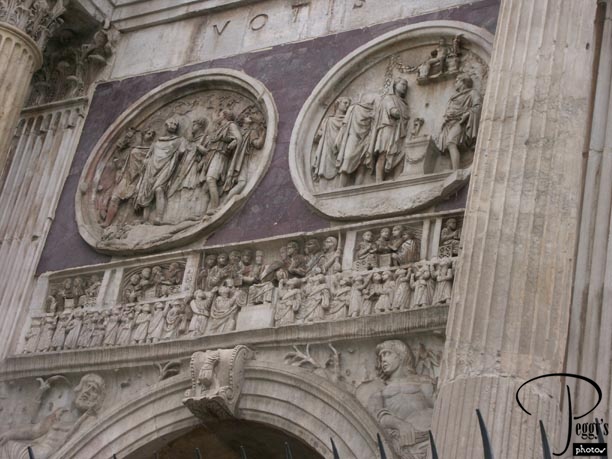
Close–up view of the arch. Note the color of the marble in it. Much of the marble used by the Romans was colored.

Arch of Constantine
Arch of Constantine

Another close–up view of the arch.

Arch of Constantine
Basilica of Constantine
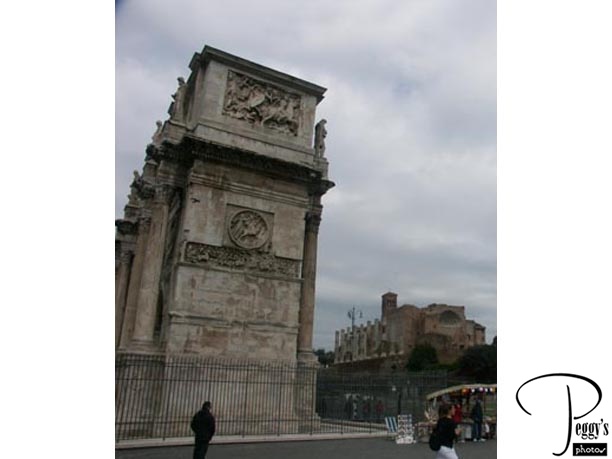
View of the Temple of Venus and Rome (on the right) from the Arch of Constantine.

Basilica of Constantine
Temple of Venus and Rome
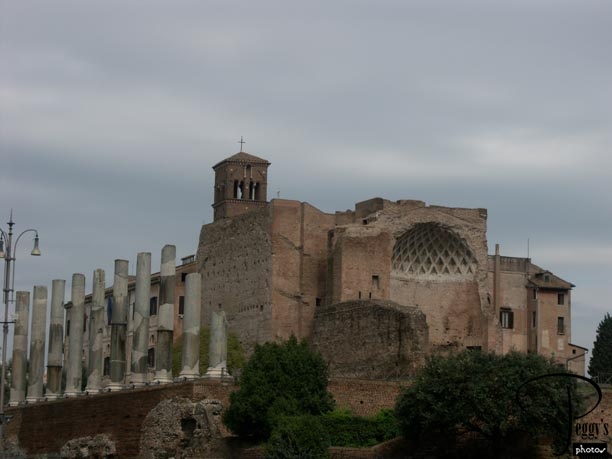
From the Colosseum, Greg led our group across the street. Here was a good view of the Temple of Venus and Rome which was built in 121 A.D. by the Emporer Hadrian. The columns that made up the colonnade around it have been re–erected.

Temple of Venus and Rome
Into the Forum
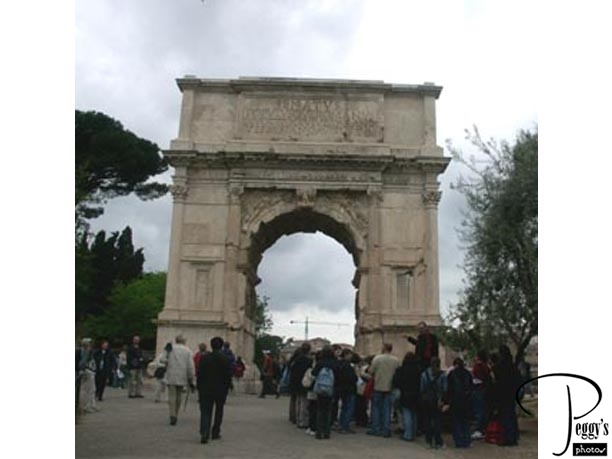
We walked into the Roman Forum through the Arch of Titus. It was erected in 81 A.D. by Emperor Domitian in honor of the victories in Judea of Emperor Titus, his brother, and Emperor Vespasian, his father.

Into the Forum
Arch of Titus
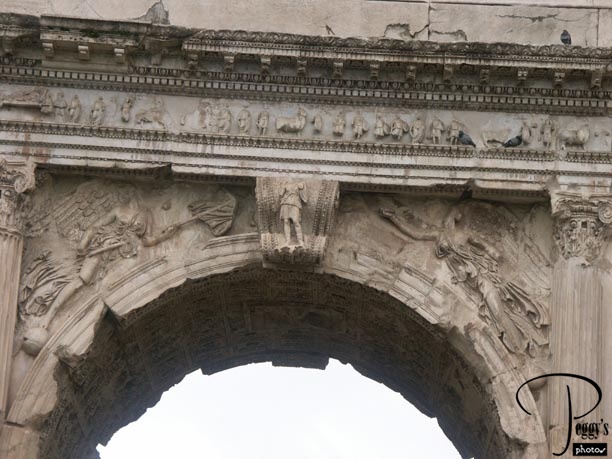
Close–up of the Arch of Titus.

Arch of Titus
Arch of Titus
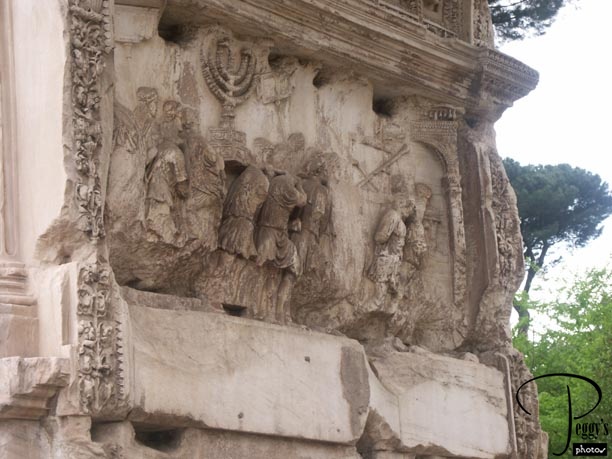
This relief shows Roman soldiers carrying off booty from the Temple of Jerusalem.

Arch of Titus
The Old Roman Road
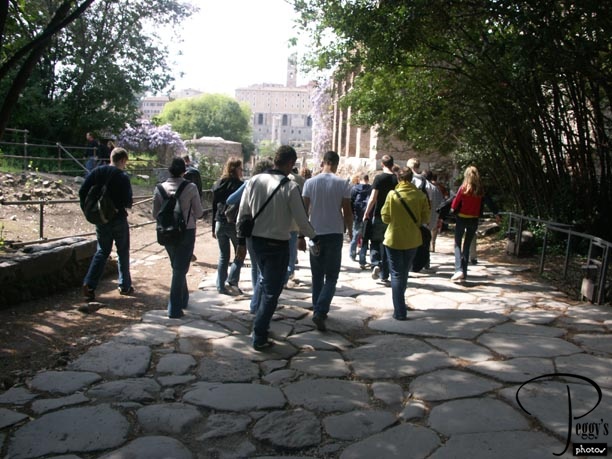
Walking down to the Forum on the Old Roman Road.

The Old Roman Road
Overview of the Forum
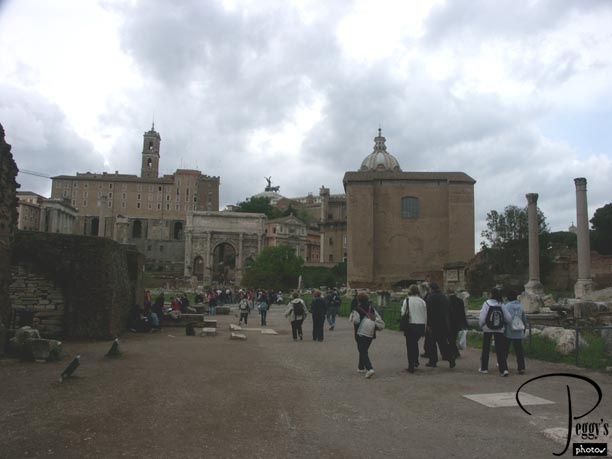
One view of the Forum.

Overview of the Forum
Overview of the Forum
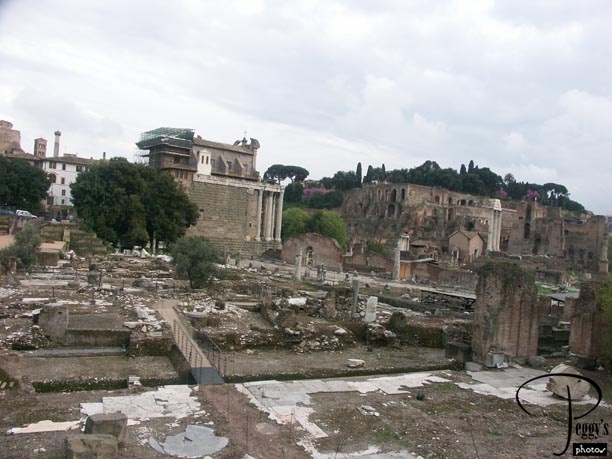
Another view of the Forum.

Overview of the Forum
Basilica of Constantine and Maxentius
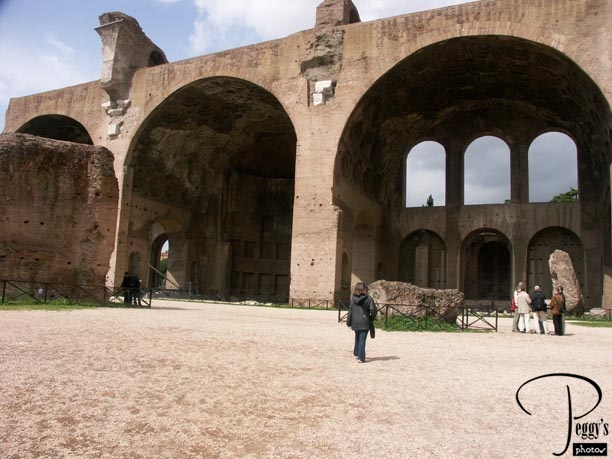
Work on this basilica was begun in 308 A.D. under the Emperor Maxentius, who was deposed by the Emperor Constantine. The basilica was finished by Constantine. The basilica was not a church but, rather, was for the administration of justice and for business transactions. However, modern religious basilicas are modeled largely on this basilica’s design.

Basilica of Constantine and Maxentius
Basilica of Constantine and Maxentius
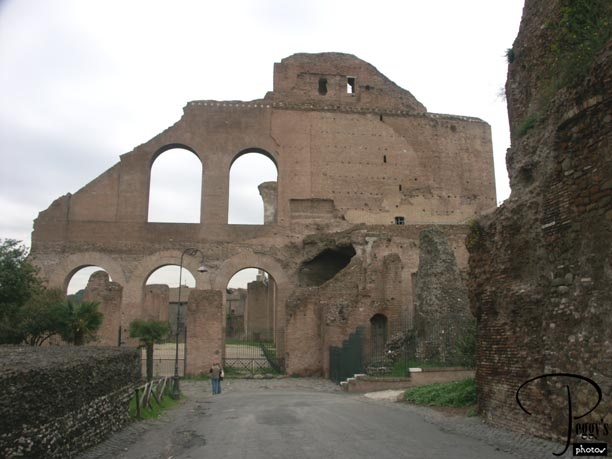
Another view of the Basilica of Constantine and Maxentius.

Basilica of Constantine and Maxentius
Temple of Romulus
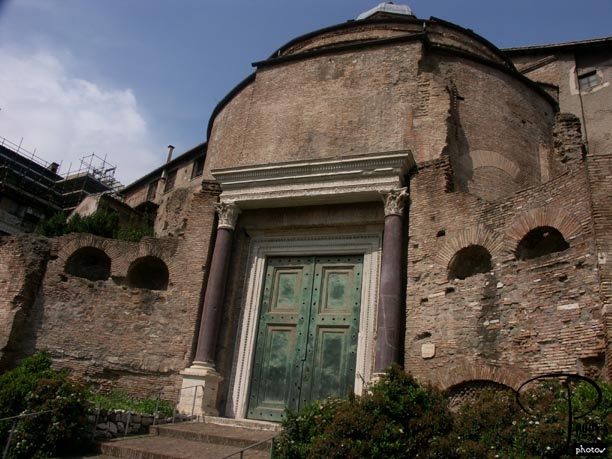
This temple was built in the 4th century A.D. The bronze doors are the original doors.

Temple of Romulus
Excavation Pit
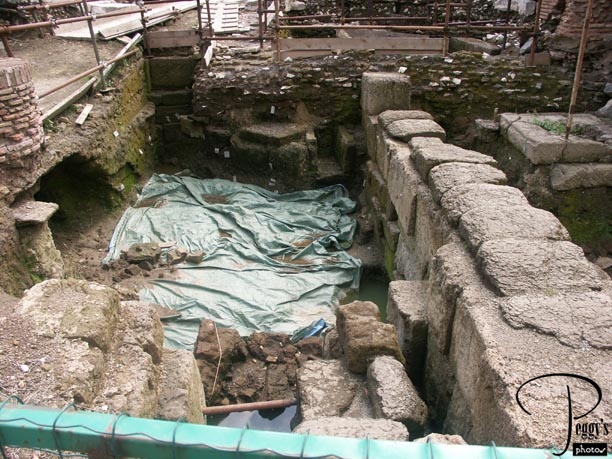
An excavation pit at the Forum. At this pit, they are now excavating below the Roman ruins and are finding Etruscan ruins below the Roman ruins. All over Rome you will see excavation pits. It is believed that 70% of the Roman ruins in Rome have not yet been excavated and this is because later buildings have been built on top of the ruins.

Excavation Pit
Temple of Antonuis Pius and Faustina
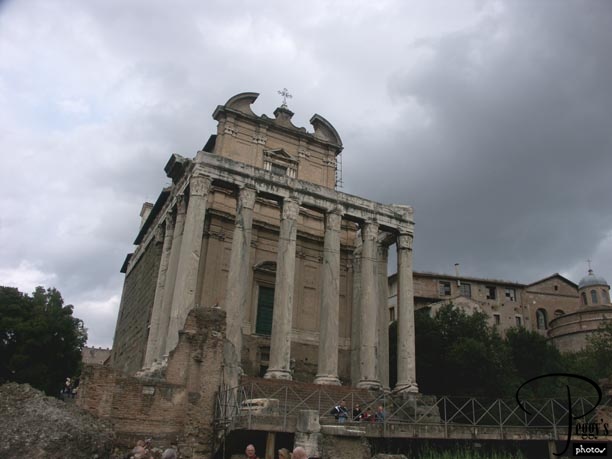
This temple was built by the Emperor Antonuis Pius (138–161 A.D.) in honor of his cherished deceased wife Faustina. The temple was reconstructed as a church in the 11th century.

Temple of Antonuis Pius and Faustina
Temple of Antonuis Pius and Faustina
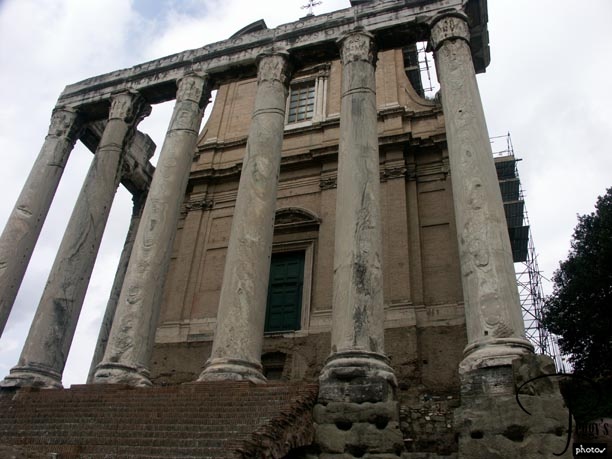
Another view of this temple. Look at where the door to the church is. Before excavation of the temple began, the Forum was covered with dirt up to the level of the church door.

Temple of Antonuis Pius and Faustina
House of the Vestal Virgins
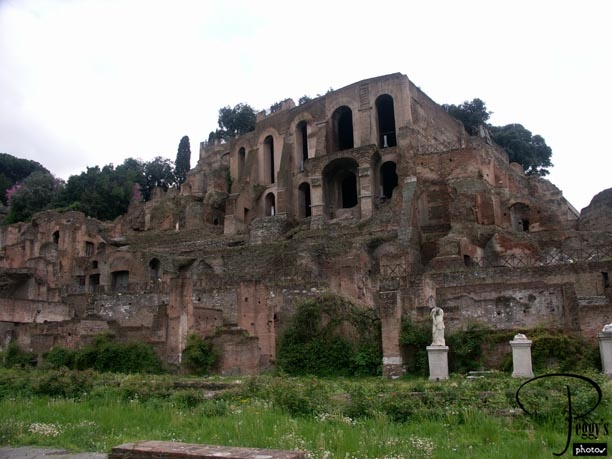
Originally, this house was of about 50 rooms and of either two or three stories depending on which book you use as a reference. A Vestal Virgin was chosen from noble families before reaching 10 years old. There were six Vestal Virgins at one time and each served for 30 years. If a Vestal Virgin abstained from having sex for all of those 30 years, she was given a large dowry and her own statue and was allowed to marry. If she didn’t abstain, she was buried alive.

House of the Vestal Virgins
Temple of Julius Caesar
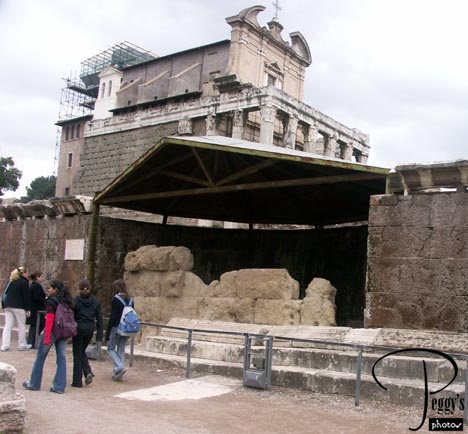
After Julius Caesar was assassinated, his body was burned at the spot under the metal roof.

Temple of Julius Caesar
Column of Phocas
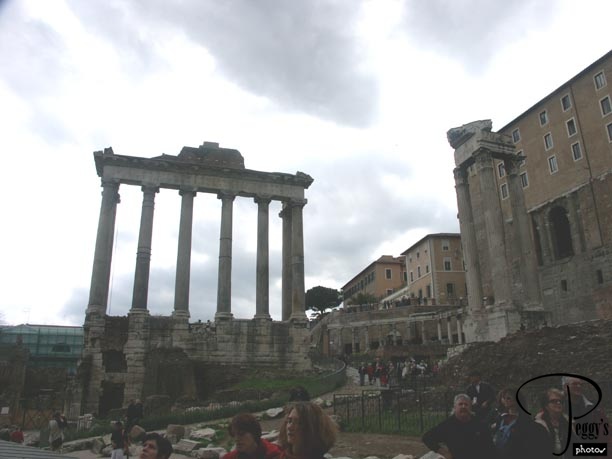
This column was a gift from the Byzantine Empire to Rome in 608 A.D. By this time, Rome had already fallen.

Column of Phocas
The Curia
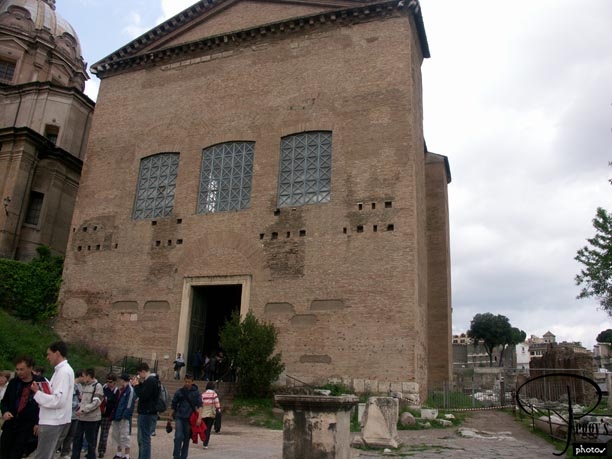
This building dates from 283 A.D. It was restored in 1937. It was the Roman Senate House––the offical center of the Roman government.

The Curia
The Curia
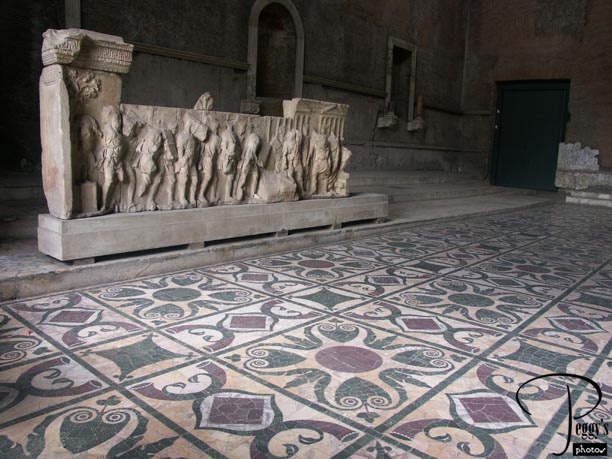
This photo shows the floor of the Curia, which is the original floor. Note the colors of the marble. The relief on the left of the photo show people standing in line to have their debts forgiven.

The Curia
Temples of Castor and Pollux and of Vesta
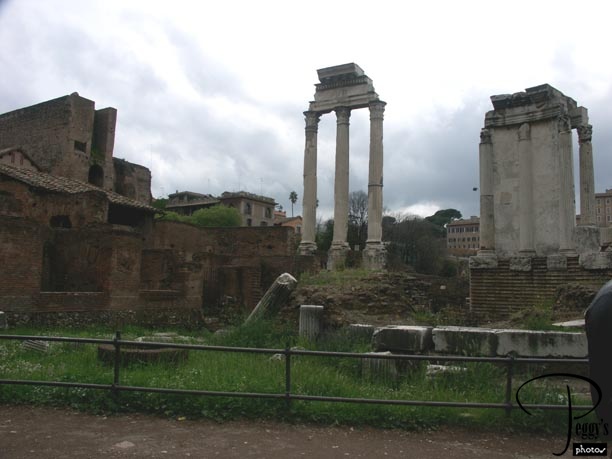
The temple in the middle of the photo is the Temple of Castor and Pollux, the mythical twins. It dates back to the 5th century A.D. On the right of the photo is the Temple of Vesta which dates back to the 4th century A.D. This temple was the most sacred spot in Rome. A sacred flame burned inside it which was tended to by the Vestal Virgins.

Temples of Castor and Pollux and of Vesta
Arch of Septimus Severus
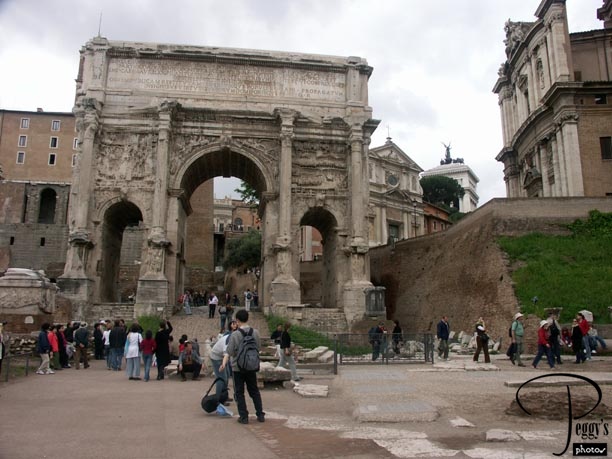
This photo shows the Arch of the Emperor Septimus Severus. It dates back to 203 A.D.

Arch of Septimus Severus
Arch of Septimus Severus

Close up of the arch. This was the end of the Roman Walks tour of the Colosseum and the Forum. It lasted 4 hours and now it was 4 p.m. Greg said he was going for lunch. I was hungry also and offered to buy him lunch (it would be my dinner). We had good conversation together for about an hour––I was impressed as to how up to date he was about everything happening in the U.S.A. He said that he talks to his mother often and also gets news from the Internet. Since he was from the Northeast and had gone to college in Boston, I told him about that attorney group from New Orleans at the restaurant last night. He said that he had given the group a tour and if he hadn’t heard their Southern accents he also would have guessed they were from either the Northeast or Boston from the way they were dressed. He said that he has heard that attorneys from Atlanta are also trying to look like they come from Boston. Must be the latest attorney trend.

Arch of Septimus Severus
Chiera SS. Nome di Maria
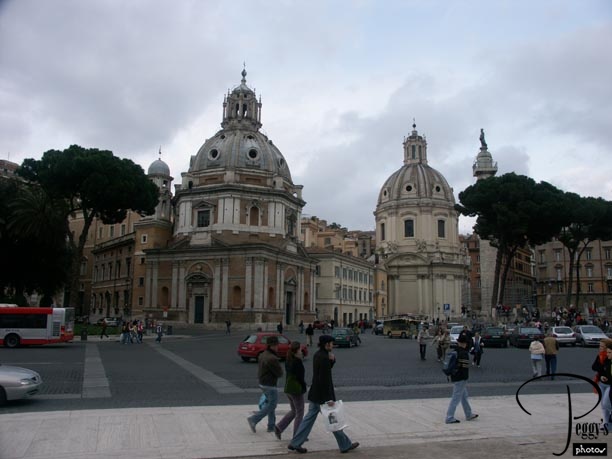
My next tour was to start at 7 p.m. at the Victor Emmanuel II Monument, which was close by. Before I left for Rome, I reserved a night walking tour with Roman Odyssey. I had some time and saw these two beautiful churches near by. I have no information on them, but wherever you walk in Rome, you are going to walk by many interesting churches and some you will want to visit.

Chiera SS. Nome di Maria
Chiera SS. Nome di Maria
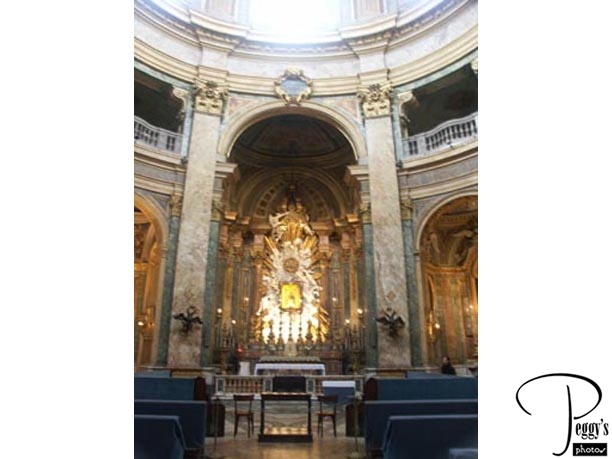
I think that I went inside the church on the left. I don’t know if these were two separate churches or if it was one connected church. This photo shows the inside of the church.

Chiera SS. Nome di Maria
Chiera SS. Nome di Maria
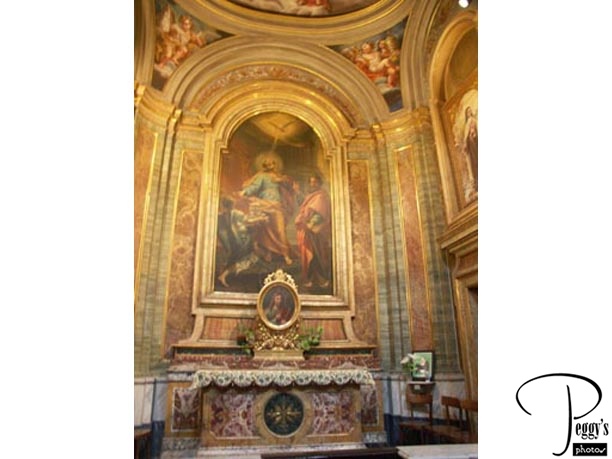
Art work inside the church.

Chiera SS. Nome di Maria
Trajan’s Markets
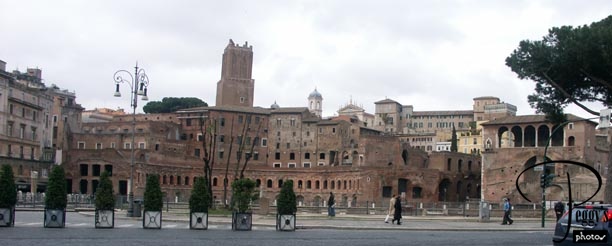
Right across the street from the Roman Forum are Trajan’s Markets. The markets were built in the 2nd century A.D. by the Emperor Trajan. It was a complex of 150 shops and offices and silks, spices, fresh fish, fruit, and flowers, etc. were sold here.

Trajan’s Markets
Trajan’s Markets
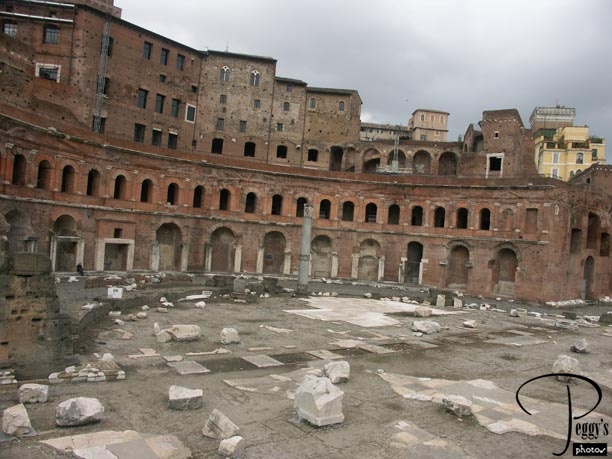
The shops here had arched entrances.

Trajan’s Markets
Trajan’s Column
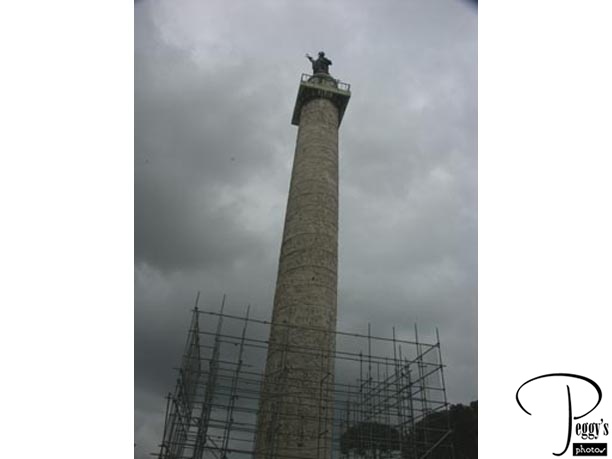
This column dates back to 113 A.D. and is 131 feet tall. It depicts the Roman campaigns.

Trajan’s Column
Trajan’s Column
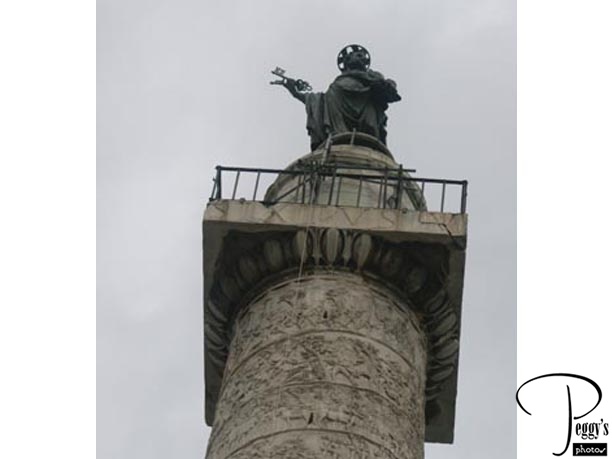
Close up of Trajan’s Column. The original statue of Trajan on top of the column was replaced in 1587 with a statue of St. Peter.

Trajan’s Column
Trajan’s Market

View of the excavation pit in front of Trajan’s Market. You can see Trajan’s Column on the left.

Trajan’s Market
Piazza Venezia
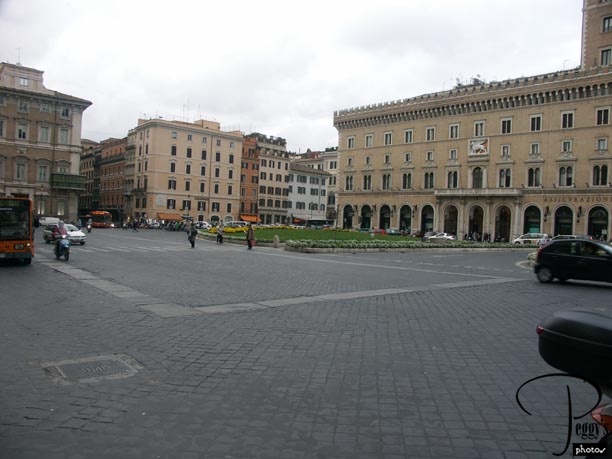
I was on my way to the Piazza Venezia to meet my tour in less than an hour. I had the Trajan Markets on my right side and the Roman Forum on my left side. I overheard a family being very excited about something they just heard on their cell phone. Could it be that the new pope was elected? A short time afterward, about 6:15 p.m., I heard church bells ringing and then another set of overlapping church bells. I did think I was correct in what had just happened. I guess I should have followed my instinct and rushed over to St. Peter’s Square. However, at that time, I didn’t have a clue of how to do this. Other than the excited family and the two sets of church bells, that was all the excitement at the Forum. Those of you watching your TV sets of this historic event experienced much much more than I did even though I was in Rome. This photo shows the Piazza Venezia, one of main squares in Rome.

Piazza Venezia
Palazzo Venezia
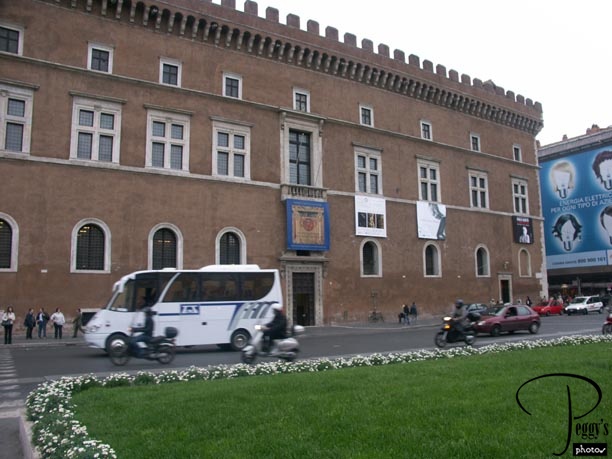
This building is on the Piazza Venezia and is of interest as it shows the balcony (Mussolini’s Balcony) where Mussolini gave his speeches.

Palazzo Venezia
Victor Emmanuel Monument
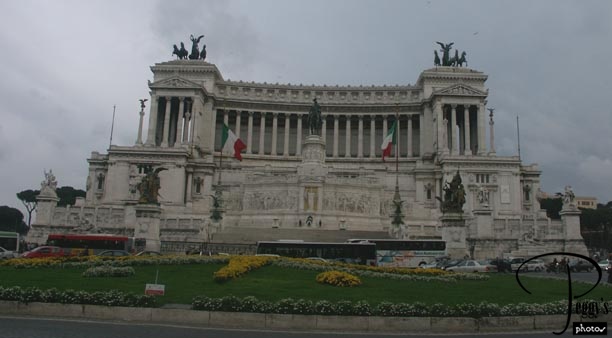
The Victor Emmanuel Monument at Piazza Venezia. This monument was started in 1885 and finished in 1911 in honor of Victor Emmanuel II who was the first king of Italy after it was unified.

Victor Emmanuel Monument
Victor Emmanuel Monument

Close–up of the statue of Victor Emmanuel II.

Victor Emmanuel Monument
Victor Emmanuel Monument
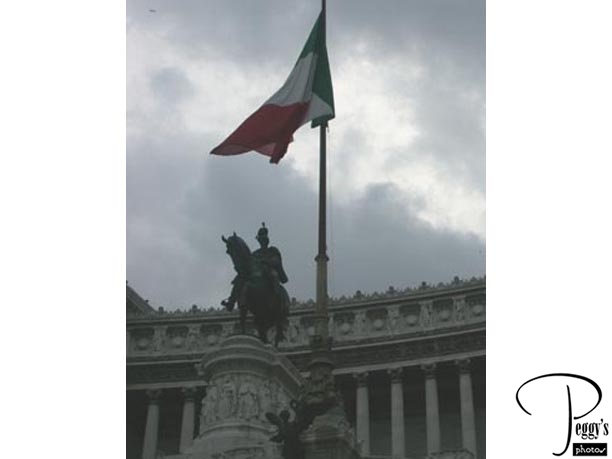
Another close–up of the statue of Victor Emmanuel II, this time with the Italian flag.

Victor Emmanuel Monument
Victor Emmanuel Monument
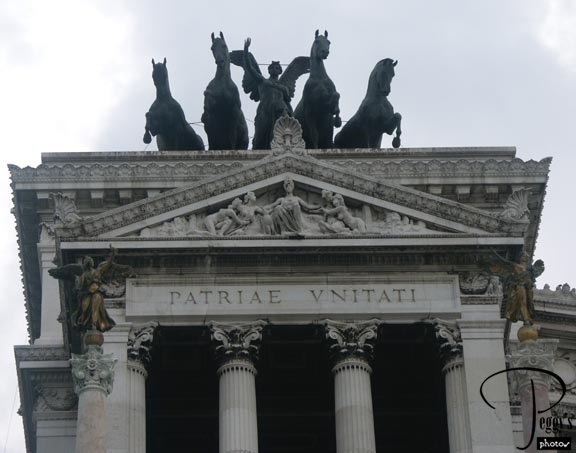
Close–up of angel and horses on top of the monument.

Victor Emmanuel Monument
Victor Emmanuel Monument
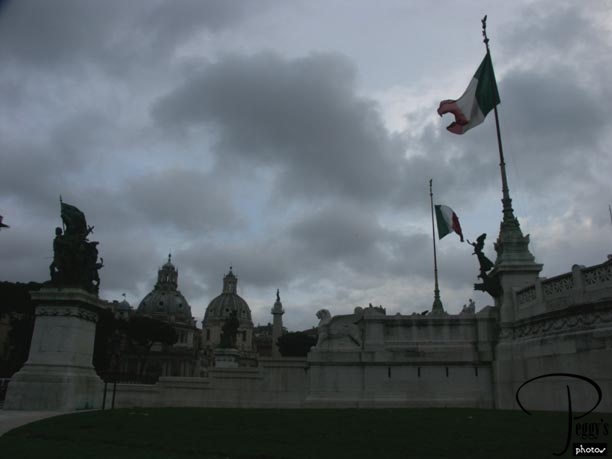
View of the two church domes from the Victor Emmanuel Monoment.

Victor Emmanuel Monument
Neptune Fountain at Victor Emmanuel Monument
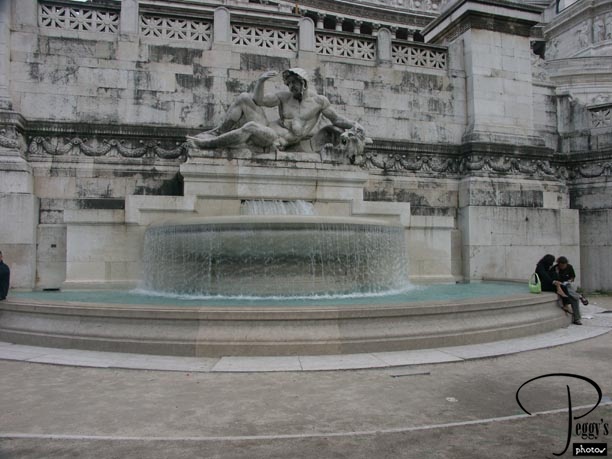
I was supposed to meet the Roman Odyssey tour at this fountain. I waited until 7:15 p.m. and no one showed up. It could have been my fault as I looked at what I thought was a confirmation of the tour and it did say that I was supposed to reconfirm the tour. Did I? I didn’t remember. Anyway, I was glad that no one showed up as I was way too tired to do any more walking. It was overambition even to schedule the tour for that night. So I walked back to the Colosseum Metro Station. I was tired and I saw that it was quicker to cross the street to the Metro in a crosswalk without a traffic light than down the street in a crosswalk with a traffic light. I tried to follow an Italian woman across the street. She stopped several lanes of high–speed traffic––our Trafalgar guide said that the way the Italians do this is to step off the curve and look at each driver with a look that means business. They will stop. I lagged too far behind the woman crossing the street and the high–speed traffic started up again. I did make it back to the curb before I was hit by a car or a motorscooter but it was close. Two sidewalk vendors started scolding me in Italian for what I had done––I deserved it. With what dignity I had left, I walked farther down the street and safely crossed at the traffic light. I got on the Metro and got off at my stop––Piazza Bologna. When I got to the street, I didn’t know what direction my hotel was in. Nothing looked familar. I stopped a woman in the street for help and she stopped a man on the street as she didn’t know where my hotel was located. This wonderful Italian man drew me a map of how to find the hotel and even called the hotel to make sure he was right. Then he asked me if I knew that there was a new pope. He said it was Cardinal Ratzinger. I said, “Oh, the German cardinal.” He was very impressed that I knew who it was (thanks to my taxi driver). I made it back to my hotel by way of the neighborhood pastry shop, but when I got to the hotel I was told that I had a fax that came in––it was from the tour company through which I had scheduled four walking tours for Thursday and Friday. All the tours had been canceled due to lack of interest (I guess tourists do not like to walk), but they offered me some other tours (coach and walking together). So I had to redo my touring itinerary and figure out where to go on my own the next days that I would not be going to on the tours. Netherless, I really had a great first full day in Rome.
